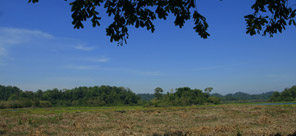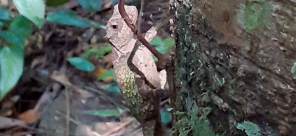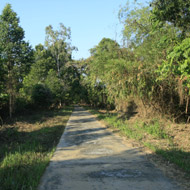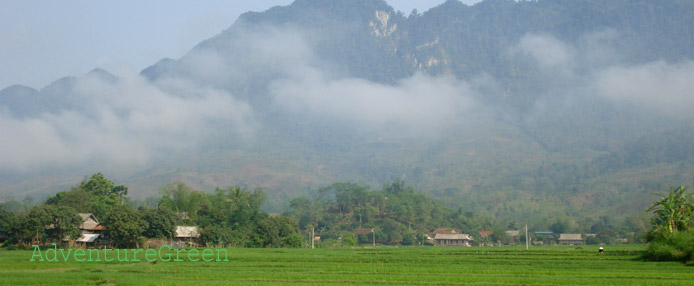Birds of Vietnam, Bird Species in Vietnam

Let's join AdventureGreen on our bird quests to learn about the different birds and bird species in Vietnam. Here you can find out more about the birding spots that these bird species are found.
- Order: Charadriiformes
- Family: Charadriidae
- Genus: Anarhynchus
White-faced plover (Anarhynchus dealbatus)
The white-faced plover (Anarhynchus dealbatus) is a small shorebird predominantly found along the coastal shores of subtropical and tropical eastern Asia.
This bird is found along a wide seaboard area of southern China and adjacent northern Vietnam ; its wintering range extends south across eastern Indochina towards Sumatra.
Charadriidae, Charadrius: Late Latin word for a yellowish bird mentioned in the fourth-century Vulgate; from Ancient Greek kharadrios a bird found in ravines and river valleys (kharadra, "ravine").
The genus name is from Ancient Greek ana meaning "backward", and rhunkhos meaning "bill".
Dealbatus is a Latin word meaning "whitewashed" or "plastered". It comes from the verb dealbare, which means "to whitewash".
- Order: Charadriiformes
The bird family Charadriidae includes the plovers, dotterels, and lapwings. The order is Charadriiformes.
Charadriidae, Charadrius: Late Latin word for a yellowish bird mentioned in the fourth-century Vulgate; from Ancient Greek kharadrios a bird found in ravines and river valleys (kharadra, "ravine").
- Order: Charadriiformes
- Family: Scolopacidae
Arenaria, commonly known as turnstone, is a genus of birds in the wader family Scolopacidae, containing only two species.
The genus name arenaria is from Latin arenarius, "inhabiting sand", from arena, "sand".
1/ Ruddy turnstone (Rẽ khoang, Arenaria interpres)
The specific epithet interpres means "messenger".
- Order: Charadriiformes
- Family: Scolopacidae
Lymnocryptes is a genus of birds in the wader family Scolopacidae, containing only one species: Lymnocryptes minimus.
1/ Jack snipe or jacksnipe (Rẽ giun nhỏ, Lymnocryptes minimus)
The genus name Lymnocryptes is from Ancient Greek limne, "marsh" and kruptos, "hidden". The species name minimus is from Latin and means "smallest".
- Order: Charadriiformes
- Family: Scolopacidae
Scolopax, commonly known as woodcock, is a genus of wading birds in the family Scolopacidae.
The genus name is Latin for a snipe or woodcock.
1/ Eurasian woodcock (Rẽ gà , Nhát bà, Scolopax rusticola)
The specific epithet rusticola is the Latin name of a gamebird which was possibly a grouse.
- Order: Charadriiformes
- Family: Scolopacidae
Calidris is a genus of Arctic-breeding, strongly migratory wading birds in the family Scolopacidae.
The genus name is from Ancient Greek kalidris or skalidris, a term used by Aristotle for some grey-coloured waterside birds.
1/ Spoon-billed sandpiper (Rẽ mỏ thìa, Calidris pygmaea)
2/ Curlew sandpiper (Rẽ bụng nâu, Calidris ferruginea)
The specific ferruginea is from Latin ferrugo, ferruginis, "iron rust" referring to its colour in breeding plumage.
3/ Red-necked stint (Rẽ cổ hung, Calidris ruficollis)
The specific ruficollis is from Latin rufus, "red" and collum, "neck".
4/ Sanderling (Rẽ cổ xám, Calidris alba)
The name derives from Old English sand-yrðling, "sand-ploughman".
The specific, alba, is Latin for "white".
5/ Sharp-tailed sandpiper (Rẽ đuôi nhọn, Calidris acuminata)
The specific acuminata is from Latin acuminatus, 'sharp, pointed'.
6/ Ruff (Rẽ lớn, Calidris pugnax)
formerly placed in different genera and was known as: Tringa pugnax, Philomachus pugnax
The specific epithet refers to the aggressive behaviour of the bird at its mating arenas — pugnax from the Latin term for "combative".
7/ Great knot (Rẽ lớn ngực đốm, Calidris tenuirostris)
The specific tenuirostris is from Latin tenuis "slender" and rostrum "bill".
8/ Temminck's stint (Rẽ Lưng đen, Calidris temminckii)
The specific epithet is from the name of a Dutch naturalist Coenraad Jacob Temminck.
9/ Red knot or just knot (Rẽ lưng nâu, Calidris canutus)
10/ Broad-billed sandpiper (Rẽ mỏ rộng, Calidris falcinellus)
The specific name falcinella is from falx, falcis, "a sickle.
Some research suggests that it should rather go into the genus Philomachus.
11/ Long-toed stint (Rẽ ngón dài, Calidris subminuta)
The specific subminuta is from Latin sub, "near to" and minuta, "small" from its similarity to the little stint, Calidris minuta.
12/ Little stint (Rẽ nhỏ, Calidris minuta or Erolia minuta)
The specific minuta is Latin for "small.
13/ Dunlin (Rẽ trán trắng, Calidris alpina)
formerly placed in the genus Erolia.
The specific alpina is from Latin and means "of high mountains", in this case referring to the Alps.
The English name derives from dun, "dull brown", with the suffix -ling, meaning a person or thing with the given quality.
- Order: Charadriiformes
- Family: Scolopacidae
Gallinago is a genus of birds in the wader family Scolopacidae, containing 18 species.
1/ Swinhoe's snipe, (Dẽ giun Swinhoe, Gallinago megala), also known as forest snipe or Chinese snipe
2/ Common snipe (Rẽ giun, Gallinago gallinago)
3/ Pin-tailed snipe or pintail snipe (Rẽ giun Á châu, Gallinago stenura)
4/ Wood snipe (Dẽ giun lớn, Rẽ giun lớn, Gallinago nemoricola)
5/ Solitary snipe (Gallinago solitaria)
The term Charadriiformes comes from New Latin, combining the Greek word kharadrios ("a bird of river valleys" or "a bird of ravines") and the Latin suffix -formes meaning "forms" or "shaped like". Therefore, Charadriiformes translates to "birds shaped like or resembling the charadrius," which is a type of plover or stone curlew historically found in dry river beds or ravines.
The word Scolopacidae is New Latin, derived from the genus name Scolopax (Latin for "snipe" or "woodcock") and the common zoological suffix for family names, -idae.
The genus name gallinago is Neo-Latin for a woodcock or snipe from Latin gallina, "hen" and the suffix -ago, "resembling".
- Order: Charadriiformes
- Family: Scolopacidae
Phalaropus is a genus of birds commonly known as phalarope.
1/ Red-necked phalarope (Dẽ cổ đỏ, Rẽ cổ đỏ, Phalaropus lobatus), also known as the northern phalarope and hyperborean phalarope
The term Charadriiformes comes from New Latin, combining the Greek word kharadrios ("a bird of river valleys" or "a bird of ravines") and the Latin suffix -formes meaning "forms" or "shaped like". Therefore, Charadriiformes translates to "birds shaped like or resembling the charadrius," which is a type of plover or stone curlew historically found in dry river beds or ravines.
The word Scolopacidae is New Latin, derived from the genus name Scolopax (Latin for "snipe" or "woodcock") and the common zoological suffix for family names, -idae.
Phalaropus (the genus name for phalaropes) comes from Ancient Greek: phalaris (meaning "coot") + pous (meaning "foot"), essentially translating to "coot-footed," because these birds have lobed toes like coots, a key feature for their swimming and feeding style.
The English and genus names come through French phalarope.
- Order: Charadriiformes
- Family: Scolopacidae
Actitis is a small genus of waders, comprising just two very similar bird species.
The genus name is from Ancient Greek aktites, "coast-dweller" from akte, "coast".
1/ Common sandpiper (Choắt nhỏ, Actitis hypoleucos)
- Order: Charadriiformes
- Family: Scolopacidae
Limosa is a genus of bird in the family Scolopacidae belonging to the order Charadriiformes.
The genus is commonly known as the gotwit comprising large, long-billed, long-legged and strongly migratory waders of the bird.
The godwits can be distinguished from the curlews by their straight or slightly upturned bills, and from the dowitchers by their longer legs.
The genus name Limosa is from Latin and means "muddy", from limus, "mud". The English name "godwit" is believed to imitate the bird's call.
1/ Black-tailed godwit (Choắt mỏ thẳng đuôi đen, Limosa limosa)
2/ Bar-tailed godwit (Choắt mỏ thẳng đuôi vằn, Limosa lapponica)
The specific name lapponica refers to Lapland.
- Order: Charadriiformes
- Family: Scolopacidae
- Genus: Numenius
Numenius is a bird genus commonly known as curlews which are characterised by their long, slender, downcurved bills and mottled brown plumage.
The English name may have been influenced by the Old French corliu, "messenger", from courir , "to run".
The genus name Numenius is from Ancient Greek noumenios, a bird mentioned by Hesychius. It is associated with the curlews because it appears to be derived from neos, "new" and mene "moon", referring to the crescent-shaped bill.
1/ Eurasian or common whimbrel (Choắt mỏ cong bé, Numenius phaeopus), also known as the white-rumped whimbrel
formerly Scolopax phaeopus.
2/ Far Eastern curlew (Choắt mỏ cong hông nâu, Rẽ mỏ cong hông nâu, Numenius madagascariensis)
3/ Eurasian curlew or common curlew (Choắt mỏ cong lớn, Numenius arquata)
The species name arquata is the Medieval Latin name for this bird, derived from Latin arcuatus, "bow-shaped", referring to the shape of the bill.
- Order: Charadriiformes
- Family: Scolopacidae
- Genus: Limnodromus
Limnodromus is a genus of waders commonly known as dowitchers. The name combines the Ancient Greek limne meaning "marsh" with -dromos meaning "-racer" or "-runner".
1/ Asian dowitcher (Choắt chân màng lớn, Limnodromus semipalmatus)






































